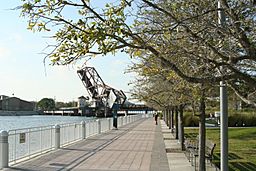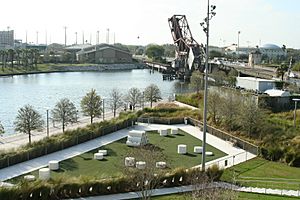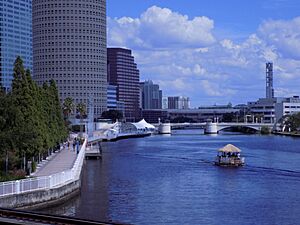Tampa Riverwalk facts for kids
Quick facts for kids Tampa Riverwalk |
|
|---|---|

A section of Tampa's Riverwalk along the Hillsborough River and Curtis Hixon Park
|
|
| Lua error in Module:Location_map at line 420: attempt to index field 'wikibase' (a nil value). | |
| Location | Tampa, Florida |
| Established | 1989 |
| Open | Year round |
| Public transit access | TECO Line Streetcar |

The Tampa Riverwalk is a cool 2.6-mile (4.2 km) path for walking and biking in Tampa, Florida. It follows the beautiful Hillsborough River through downtown Tampa. This path connects many exciting places like parks, museums, and hotels.
You can explore the Tampa Bay History Center, the Tampa Convention Center, and Curtis Hixon Waterfront Park. There's also Water Works Park and an arts area with the Tampa Museum of Art and Glazer Children's Museum. Many fun events happen here, especially festivals at Curtis Hixon Park. You might even see the "pirate ship" Jose Gasparilla docked during the Gasparilla Pirate Festival! The city created the Riverwalk to show off Tampa's amazing waterfront.
Contents
How the Riverwalk Started
The idea for the Riverwalk began in the 1970s. Back then, much of downtown Tampa's riverfront had old warehouses. Mayor Bill Poe imagined a park and walkway behind a civic center called Curtis Hixon Hall. A small part of the boardwalk was built, but money problems and a lack of interest stopped it for a while.
In the mid-1980s, Tampa decided to make its downtown better. Over the next ten years, the old Curtis Hixon Hall was replaced by a park. New buildings like the Tampa Convention Center were also built along the water.
Building the Path
In 2002, Pam Iorio became mayor and promised to finish the Riverwalk. Construction started on new parks and connecting paths. The project grew in stages with money from the city, donations, and government grants.
A big step happened in 2010 when Curtis Hixon Waterfront Park, a new Tampa Museum of Art, and the Glazer Children's Museum opened. These were near where the first boardwalk was built. Bob Buckhorn, the next mayor, also strongly supported the Riverwalk.
In 2014, a grant helped build a boardwalk under the Kennedy Boulevard bridge. This connected all the existing parts into one continuous path about two miles long. By 2016, the path was extended even further north. It now goes past the Straz Center for the Performing Arts to Waterworks Park. This made the total length of the Riverwalk 2.6 miles (4.2 km).
What You Can Do on the Riverwalk Today
The Tampa Riverwalk is now a popular spot for everyone. It's a busy path connecting many downtown attractions and hotels. You can walk, bike, or even rent motorized scooters. A water taxi also takes people to nearby areas like Hyde Park and Harbour Island. The TECO Line Streetcar runs nearby, connecting to downtown and the historic Ybor City neighborhood.
Exciting Plans for the Future
In 2022, the city announced plans for new parts of the Riverwalk. These new sections will be on the west side of the Hillsborough River. They will stretch into the West Tampa neighborhood. These new paths will connect to a "Green Spine" of walking and biking trails. This will add another 6 miles (9.7 km) to the project, creating a large loop around the river.
Lights and Art Along the Way
The city has added cool color-changing LED lighting to parts of the Riverwalk. These lights make the path and nearby bridges look amazing at night. They can even change colors for special events! For example, they might be green and gold for University of South Florida graduations.
Honoring Tampa's Heroes
In 2012, a special project called the Historical Monument Trail began. Bronze statues of important people from Tampa's past were created. Historians helped choose these figures. The first people honored included:
- Vicente Martinez Ybor, who founded Ybor City.
- Henry B. Plant, who built railroads and the famous Tampa Bay Hotel.
- Eleanor McWilliams Chamberlain, a leader in Florida's women's voting rights movement.
- Clara C. Frye, who started Tampa's first hospital that welcomed everyone.
- James McKay Sr., an important mayor of Tampa.
- The Mocoso, Tocobaga, and Pohoy indigenous peoples, who were the first inhabitants of the area.
More heroes have been added over the years. By 2022, thirty historical figures were honored. Some others include:
- Blanche Armwood, an educator and community leader.
- Edward Daniel Davis, a local educator and civil rights advocate.
- Cody Fowler, a local lawyer and civil rights advocate.
- Herman Glogowski, the first Jewish mayor of Tampa.
- Ossian B. Hart, a governor of Florida who supported civil rights.
- Kate V. Jackson, a businesswoman and environmentalist.
- Peter O. Knight, a key politician during Tampa's early growth.
- Victoriano Manteiga, who founded La Gaceta, a unique tri-lingual newspaper.
- Benjamin Elijah Mays, a nationally known educator and mentor to Martin Luther King Jr..
- Paulina Pedroso, an activist for Cuban independence and civil rights.
- Garfield Devoe Rogers, a businessman and philanthropist.
A Colorful Mural Under the Bridge
In 2016, a special mural called "Woven Waves" was added under the Laurel Street Bridge. This mural changes as you walk by, like a cool optical illusion! It was designed to look like a quilt, inspired by the river's currents and Tampa's diverse cultures.



